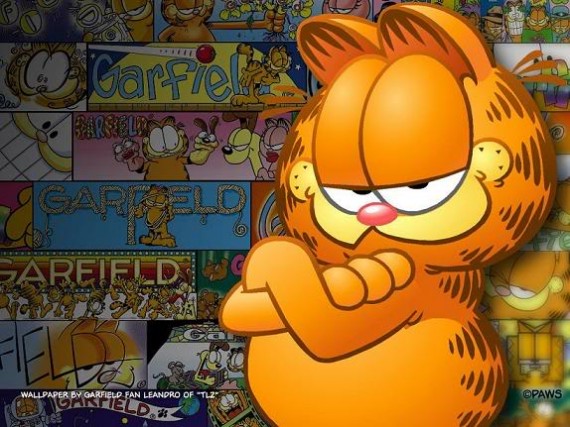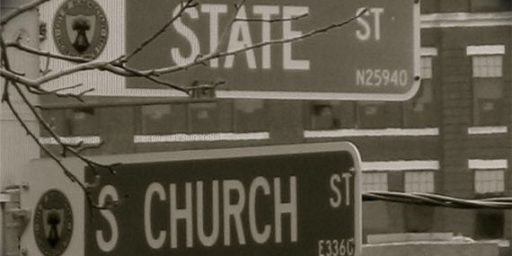Garfield Isn’t Funny and Was Never Supposed to Be
Slate repurposes a Quora piece titled “Is Garfield Supposed To Be Funny?” that itself repurposes a 2004 Slate piece titled “Garfield: Why we hate the Mouse but not the cartoon copycat.”
Well, two can play at that game. Okay, three. Four?
Anyway, this is from Chris Suellentrop’s 2004 original:
Davis’s genius is that he’s created the most widely syndicated comic strip in history—with the attendant profusion of plush toys, T-shirts, and themed Caribbean cruises—and yet, through careful brand management, he’s largely managed to deflate the naturally occurring cultural counterattack.
[…]
Davis makes no attempt to conceal the crass commercial motivations behind his creation of Garfield. Davis has the soul of an adman—his first job after dropping out of Ball State, where he majored in business and art, was in advertising—and he carefully studied the marketplace when developing Garfield. The genesis of the strip was “a conscious effort to come up with a good, marketable character,” Davis told Walter Shapiro in a 1982 interview in the Washington Post. “And primarily an animal. … Snoopy is very popular in licensing. Charlie Brown is not.” So, Davis looked around and noticed that dogs were popular in the funny papers, but there wasn’t a strip for the nation’s 15 million cat owners. Then, he consciously developed a stable of recurring, repetitive jokes for the cat. He hates Mondays. He loves lasagna. He sure is fat.
The model for Garfieldwas Charles Schulz’s Peanuts, but not the funny Peanuts of that strip’s early years. Rather, Davis wanted to mimic the sunny, humorless monotony ofPeanuts‘ twilight years. “After 50 years, Snoopy was still laying in that dog house, and rather than getting old, it actually has the opposite effect,” Davis told the Chicago Sun-Times last year during the press blitz for Garfield‘s 25th anniversary. “It says to all of us, some things in life can be counted on, they’re consistent.” In In Dog Years I’d Be Dead, a book to commemorate Garfield‘s 25th anniversary, Davis calls the Peanuts licensing machine “a template that I could apply to Garfield.” In his very first week, Garfield aped Snoopy by declaring, “Happiness is a warm television set.”
From the beginning, Davis put as much energy into the marketing of the strip as he did into creating it. (It’s telling that he’s been inducted into the Licensing Merchandiser’s Hall of Fame but not the hall of fame hosted by the International Museum of Cartoon Art.) In 1981, only three years after the strip’s debut, he set up Paws, Inc., a privately held company to handle the licensing of Garfield products. Originally, Paws did only the creative work needed for product design, while Davis’ syndicate managed the business side, but in 1994 Davis purchased the rights to license Garfield products from the syndicate for a reported $15 to $20 million. Even before that, Davis took an active role in the selling of his creation. Before agreeing to a deal with Alpo to put Garfield’s face on a new line of cat food, Davis visited the company’s plant, talked to its employees, and spoke with the grocery industry about the company’s reputation. In his 1982 interview with Shapiro, Davis admitted to spending only 13 or 14 hours a week writing and drawing the strip, compared to 60 hours a week doing promotion and licensing.
Garfield’s origins were so mercantile that it’s fair to say he never sold out—he never had any integrity to put on the auction block to begin with. But today Davis spends even less time on the strip than he used to—between three days and a week each month. During that time, he collaborates with another cartoonist to generate ideas and rough sketches, then hands them over to Paws employees to be illustrated.
Quora informationista Caroline Zelonka adds this insight:
Garfield was never intended to be humorous. The joke’s always the same because it follows a bland humor formula well-known to anyone in advertising: enough to put a smile on someone’s face, but take care never to offend. And if the humor has to suffer for it, fine.
The character was created to fill a niche among cat people, just as Snoopy had with dog owners. And, in my opinion, to make Jim Davis rich. No, he doesn’t write the strip anymore, but the strip isn’t what’s important: what with the movies, plush toys, branded pet food, even the “Garfield Pizza Cafe” in Kuala Lumpur.
The strip serves to keep Garfield in the public eye as a creative character, but the public eye isn’t really on print newspapers that much any more, and the daily newspaper comics section is probably one of the most moribund elements of popular culture in existence today. Good for Davis in maximizing the potential of his creation, but as a humor, it has dubious roots. Peanuts and The Family Circle were actually funny, once upon a time. Garfield, not so much.
So, now you know. Or have been reminded. Or whatever.






And all this time I thought it was me.
Hmmm. I remember the very early Garfield, where the jokes were much different (and indeed funny) and Garfield looked much less cute. Were those generated pre- or post- market analysis?
I’m not going to believe that there ever was a time that Family Circus was ever funny. Prove it, please! Ever since I was a kid (now 50 years ago) I remember FC as a saccharine goopy mess for the sort of people who buy mugs saying “World’s Best Grandma!” and a silhouetted background of the Des Moines skyline.
@grumpy realist:
I found some old comic books in my cousin’s collection of the original Garfield. It wasn’t funny in the same way Calvin and Hobbes was funny, but it was far better than what later developed.
Relatedly, I found a family circus comic book at a yard sale, published in the 1960s. It was just as sh*tty then as it is now.
Isn’t this segment kind of saying “man wants to start career as professional cartoonist and therefore does things that give him a chance of becoming a successful cartoonist. Be upset.”
If he said “I hate the character and hate cartoons and don’t care about you people and am in it for
the money.” then I could understand, but he didn’t. Creating and producing a cartoon that is marketable and lends itself to merchandise is likely how you get a job in the field. I’m sure there are some people out there who solely wrote a cartoon for fun and never expected it to be a career until they were discovered. He is not one of those people, there’s nothing wrong with that.
That’s just how long it takes him to produce Garfield. Should he purposefully be less productive so that the time spent promoting is closer to the time spent writing and drawing?
If the article is some elaborate trolling then I guess I’ve been successfully trolled.
@Rusty Shackleford: “Isn’t this segment kind of saying “man wants to start career as professional cartoonist and therefore does things that give him a chance of becoming a successful cartoonist. Be upset.””
It’s the same reason why a certain segment of comic fandom loathes Stan Lee. He’s prospered while supposedly more talented creators have floundered.
Mike
@MBunge: “It’s the same reason why a certain segment of comic fandom loathes Stan Lee. He’s prospered while supposedly more talented creators have floundered.”
And most of that segment is morons who have no idea what they’re talking about.
It’s true that Stan has ended up with more credit than maybe he deserved — but a lot of that is because he’s a born self-promoter and schmoozer. I had a partner for 25 years who was pretty much the same way — he loved (and loves!) talking about himself, promoting himself… loves the social aspects of the job while I never did. So he was always the more public face of the partnership, and if some people chose to give him all the credit, then that was more than a little bit my fault.
But aside from self-promotion, one of Stan’s great gifts was collaboration. None of the “supposedly more talented creators” he worked with did anything on their own with a fraction of the impact of the work they did with him… just as his work without them has been a shadow of the great stuff. Have you ever tried to read Ditko’s solo stuff?
If you have a sufficiently warped sense of humor, the changes required to make Garfield funny are quite minor:
http://www.nytimes.com/2008/06/02/business/media/02garfield.html
@Rusty Shackleford:
There’s this:
Also, on the subject, do you remember Davis’ comic from 1986, U.S. Acres? Created by Davis, every strip signed by him, but it was made in a “factory”. I doubt he wrote or drew anything other than his name, well, actually, they probably used a stamp for that…
@grumpy realist:
“Who laughed at this one-frame comic?”
Not Me!
/I’ll let myself out
There are few one-frame cartoonists I find funny. Charles Booth. Charles Addams. And whoever does the political cartoons for The Economist–the best was a “Britain storms into the next decade” Economist cover which had Neil Kinnock and Maggie Thatcher seated on a very disgruntled-looking donkey. Neil was holding a stick from which dangled another stick in front of the donkey’s nose, and Maggie was whacking the donkey with a carrot….
When I was a kid in the ’80s, Garfield was actually funny. While hardly the greatest comic strip in the world, it was pretty good. And it did definitely hold some appeal to cat owners like myself (I had cats continuously from the time I was 4 to 34). For example, I remember one where Jon is trying to coax Garfield into the car to take him to the vet under the ruse that he’s just going for a ride (this was a running gag), and he finds Garfield up in a tree. He asks “How do you always know?” and Garfield, in a thought bubble, says, “I don’t know. I just know.” Anyone who doesn’t get that joke has probably never owned cats.
Unfortunately, there was a point when the comic strip stopped being funny, Garfield came to seem less and less like a real cat, and the strip turned into an endless, dreary series of jokes based on the themes of “Jon is a dork” and “Odie is stupid” and “Garfield is a selfish bastard” and so forth.
The statement that “The character was created to fill a niche among cat people, just as Snoopy had with dog owners” overlooks how unbalanced the matter is in our culture. Despite the fact that more Americans own cats than dogs, our popular culture–in products ranging from Lady and the Tramp to Meet the Parents–is wildly, almost viscerally, anti-cat and pro-dog. In most movies and shows and cartoons and the like that deal with the subject, cats (anthropomorphic or otherwise) are portrayed as mean, aloof, snobby, and hard to relate to, and people who own cats are portrayed as weird if not evil (think Blofeld). Garfield was always a major exception to that rule, and for that reason I feel some need to defend it, in spite of how boring and unfunny it became.
I spent very little time being amused by Garfield, and haven’t followed it in a couple of decades, but a few months ago I stumbled across a Sunday strip that actually made me laugh out loud, then cut out and keep the strip.
This was truly inspired.
@grumpy realist:
In terms of one-frame cartoonists, Gary Larson’s “Farside” many times had me laughing so hard it was hard to breath. Can’t think of any other such cartoonists, off hand.
I think there were a few good Garfield’s I’ve seen in the papers over the years. Maybe the humor sometimes sneaks in despite the author’s attempt to keep it bland.
@wr: Good god, you actually said something coherent, on-topic, and meaningful! Statistics said it was bound to happen some day, but I didn’t think I’d actually live to see it.
That is a very good summation of Stan Lee, as well as his collaborators like Kirby, Ditko, even Romita and the Buscemas. I had not thought of it in that context, but it makes a great deal of sense. Lee needed great artists to have the proper synergy, and those artists needed Lee as well.
I remember the original concept behind Galactus was “The FF fight God,” and Lee took that idea from Kirby and created Galactus. It took the two of them to make that idea work.
@OzarkHillbilly:
….it doesn’t preclude you… you could both have been intended to not be humorous….
(rimshot)
Larsen, Kliban, Berke Breathed (early Bloom county), Bill Watterson, Stephan pastis, and early Charles Schultz. Some of the best.
@rodney dill: I’d toss in Jef Mallett and Frazz to that list. His style has a LOT of Watterson in it, but it’s not simply “Calvin grows up to be a high school janitor who’s also a bicyclist/songwriter.” It’s got nearly the same vibe, but it’s not a ripoff or a tribute.
And for sheer brilliance, Randall Munroe and his xkcd.com. Also, charming in its own way is Doug Savage’s “Savage Chickens.” That is, if you’re willing to include online-only cartooning.
@Stormy Dragon:
On the other hand, Lasagna Cat leaves the strips untouched and is pure genius.
@Jenos Idanian #13: I agree with XKCD, haven’t followed Frazz much.
@Al:
There’s also the Garfield Randomizer
@Stormy Dragon: Garfield minus garfield is much funnier than the original strip. In a sort of Jon is a schizophrenic type way.
http://garfieldminusgarfield.net/
Damn, I had the idea for the Dysfunctional Family Circus back in 1999 and actually used to post (disturbingly) re-captioned cartoons in my cubicle. Family Circus can be funny, you just need better writing:
http://knowyourmeme.com/memes/dysfunctional-family-circus
@Dave:
Yes, hence my linking to a New York Times article about it. ;P
So if you hate Garfield, you get to be an expert on it?
Not something I’d condone, but it must be pretty cool.
@george: Oh yes, how can I forget the Far Side? There’s also Sidney Harris, who has produced some seminal cartoons as well.(Probably best known for the “then a miracle happens here” Another science cartoonist (who I think only produced one book, unfortunately) is whoever did Jocular Science.